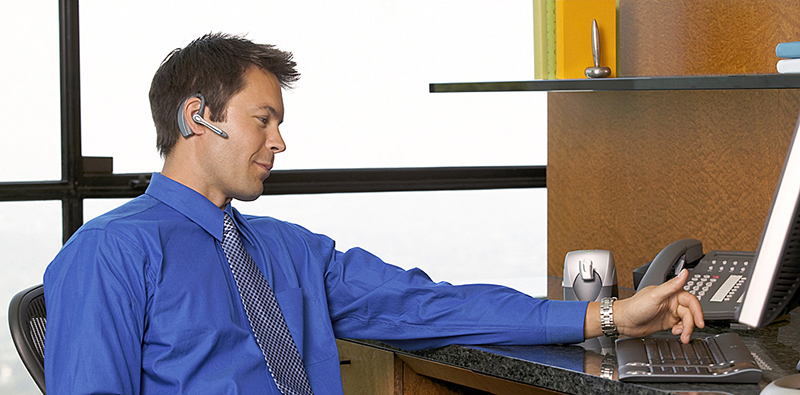
Crystal-Clear Communication a Sweet-Sounding Success
Originating Technology/NASA Contribution
“That’s one small step for man, one giant leap for mankind.”
On July 20, 1969, millions were glued to their television sets when NASA astronaut Neil Armstrong offered these famous words via live broadcast, upon becoming the first man to ever step foot on the Moon.
This historic transmission was delivered from Armstrong’s headset to the headsets of Mission Control personnel at NASA, and then on to the world. To ensure that this message was delivered loud and clear to all, NASA collaborated with private industry to deliver the best headset-communication technology possible. Today, the heart of this technology beats in a high-end line of lightweight and wireless solutions for homes, offices, contact centers, and dispatch centers.
Partnership
During the late 1950s and early 1960s, most commercial and military pilots were employing communications headsets that proved to be clunky and cumbersome. A number of these pilots changed to hand-held microphones in place of the uncomfortable headsets; but as high-performance jet planes evolved, the headset became essential as a safety feature.
In a move to make pilot headsets more uniform and comfortable, United Airlines put out an open solicitation in 1961, inviting anyone who was interested to tender their ideas for an improved design. Courtney Graham, a United Airline pilot, was one of the many who thought the heavy headsets should be replaced by something lighter. Graham was interested in submitting a new design concept to United Airlines, so he recruited a friend named Keith Larkin to be his business partner. Larkin had been working for a small company called Plane- Aids, importing spectacles and sunglasses that contained tiny transistor radios from Japan.
Their original design was inspired by these radio-equipped glasses. They submitted this concept to United Airlines for review, though they quickly learned that it would not be feasible for use, as not all pilots wore glasses or preferred wearing sunglasses while flying. Consequently, Graham and Larkin came to find that a headset using a lightweight headband would be more practical. For the communication aspect of the headband, Larkin added an acoustic tube to two very small transducers commonly used in hearing aids, for use as both a microphone and a receiver.
United Airlines accepted this headband design, which immediately evolved into the MS-50 headset. Graham and Larkin’s successful solution motivated them to start a company of their own, Pacific Plantronics, Inc. (now called Plantronics, Inc.).
In 1962, the newly formed, Santa Cruz, California-based company introduced the MS-50 to the aviation industry as the world’s first lightweight headset. United Airlines started ordering the new headsets for its pilots shortly thereafter, and the Federal Aviation Administration adopted a modified version for air traffic control; United Airlines is still using the MS-50 today.
Graham and Larkin soon found out that it was not just the aviation industry that was experiencing problems with the uncomfortable headsets of the time—astronauts, telephone operators, and call centers, too, had similar issues.
NASA was looking to outfit its astronauts with a lightweight, self-contained radio after it had lost contact during a dire situation. Lieutenant Colonel Virgil Ivan “Gus” Grissom was the command pilot of 1961’s Liberty Bell 7 (Mercury-Redstone 4) mission, America’s second manned space flight. Following the space mission, the Liberty Bell 7 capsule had a successful reentry into Earth’s atmosphere and experienced a relatively mild impact when it landed in the Atlantic Ocean.
The capsule righted itself after splashdown and all seemed well, but minutes later, while Grissom was preparing for rescue by a helicopter scheduled to retrieve him and the capsule, its explosive hatch blew prematurely, causing water to gush in and flood the cabin.
According to the pre-established plan, the explosive hatch was not to be blown until the capsule had been lifted clear from the water. Because the hatch blew too early, Grissom was forced to exit the flooding Liberty Bell 7, thereby abandoning all of the spacecraft’s radio communications equipment, and since the helmets of astronauts were not equipped with radio communications in the early days of space flight, he was unable to make contact with his recovery team.
Grissom was able to free himself and get the visual attention of the helicopter circling above for safe rescue, though the recovery team had no choice but to part with the spacecraft, due to the added weight of the water that had flooded it.
NASA did not want to risk losing radio contact with an astronaut again, so it contracted with ITT Labs, in Fort Wayne, Indiana, to develop a self-contained radio system. ITT Labs delivered to NASA a radio transceiver called a Kellorad unit, which happened to feature Pacific Plantronics’s MS-50 headset.
When NASA astronaut Walter “Wally” Schirra first saw the lightweight headset component of the Kellorad unit, his interest—and curiosity—peaked. He contacted Pacific Plantronics and asked the company whether the MS-50 receiver could be implanted directly in his astronaut helmet. Pacific Plantronics was confident that it could satisfy Schirra’s request, so NASA awarded the company a contract to do so.
Pacific Plantronics assembled its Space Environmental Communications (SPENCOM) division to begin working on a reliable solution. SPENCOM personnel traveled to NASA’s Manned Spacecraft Center (now Johnson Space Center) and Kennedy Space Center to meet with and get design feedback from Schirra and several other astronauts, including Gordon Cooper. (Schirra and Cooper were two of the seven original NASA astronauts.) Based on the feedback provided, Plantronics and NASA decided to focus on a noise-canceling microphone that used dual, miniature transducers. A helmet receiver using the miniature transducers was also developed. The SPENCOM group worked in conjunction with Manned Spacecraft Center engineers to design and implement the new noise-canceling microphone and receiver.
SPENCOM and NASA had a working microphone design with the correct impedance needed for space communications within 11 days, and Schirra was the first to use the new communication technology during the Sigma 7 (Mercury-Atlas 8) mission.
Unfortunately, ground control lost contact with Schirra for approximately 7 critical seconds during the “Max Q” phase of liftoff, when the most noise was introduced into the capsule, because aerodynamic pressure was at its highest. Changes had to be made to compensate for this noise level, so the design team added a dual-tube, noise-canceling device to the microphone. The transmission using the new noise-canceling technique provided greatly improved communication.
The improved unit was developed for the Faith 7 (Mercury-Atlas 8) mission, the follow-up mission to Sigma 7, commanded by Cooper, and continued to be successfully used through the Gemini, Apollo, and Skylab missions.
Pacific Plantronics gained increasing recognition as a result of participating with the Space Program, as the advancements made for astronaut communication flourished in other markets. By year 6 of operation, the company’s sales reached $5.4 million, with 100,000 headsets in use. The Plantronics of today credits its collaboration with NASA and NASA’s use of the jointly developed microphone technology for this instant market credibility.
Product Outcome
Plantronics’s entire line of communications headsets and telephony solutions leverages the company’s expertise in mission-critical headset design and development for NASA. Its CA10CD cordless push-to-talk headset and amplifier serve as the perfect solution for contact centers, extending cordless mobility to the entire line of Plantronics professional headsets. Recognized as a Certified Space Technology by the U.S. Space Foundation, the CA10CD offers hands-free operation for up to 150 feet away from the base unit, dual volume control for optimum sound and clarity, remote-call answering, and a rechargeable battery that allows 8 hours of continuous talk time. Whether it is picking up the latest fax across the hall or checking reference materials on the other side of the building for a customer, the CA10CD gives call center agents and other business professionals room to roam.
The CA10CD also made its way into radio dispatch centers at police, fire, taxi cab, waste management, and utility company facilities. Additionally, NASA uses this product in a variety of applications, including refueling, field testing, and vehicle-assembly and range-management operations.
In the office setting, the Plantronics CS50 Wireless Headset System enables a hands-free workstyle that suits the needs of today’s busy professionals, enhancing their freedom and efficiency. The sleek, self-contained wireless CS50 addresses the number one product concern of business professionals who have chosen not to use a tethered headset: they do not want to be tied to their desks or have a wire in the way (based on a Plantronics study). With the CS50, office professionals can communicate up to 300 feet away from their desk phone, for up to 8 hours. The lightweight headset also uses built-in digital encryption so conversations are secure.
The CS50’s wireless mobility also gives businesses an important competitive advantage. Most workspace is unoccupied for 60 percent of the workday, and every day more than 70 percent of business calls are missed (UNWIRED, 2003). This means that valuable time is lost exchanging voicemails. The CS50 effectively reduces phone tag, letting users not only roam hundreds of feet from their desks, but, with the addition of the optional HL10 handset lifter, answer and end calls remotely. Since the CS50 is as intuitive and easy to use as answering the phone, the learning curve is minimal.
“In a fast-paced, people-powered business like ours, the phone is a powerful and indispensable tool. The CS50 has greatly improved my department’s accessibility and productivity,” said Adam Keen, vice president of special projects for MGM and United Artists. “The CS50’s combination of mobility and comfort enables us to multitask much more effectively. Also, unanswered calls are now a rarity, which means there’s less chance we’ll miss out on something important.”
CS50 users can satisfy their individual style and comfort preferences and gain additional convenience and functionality with optional accessories. Beyond the HL10 handset lifter that provides one-touch call answer/end, there is a behind-the-head neckband, which provides another style option for personal comfort, and a wall- or desk-mountable in-use indicator that lets others know a user is on a call.
On the home-consumer front, Plantronics technology is enhancing the overall experience for video game enthusiasts. In August 2004, the company announced that it had shipped more than 1 million headsets to the Microsoft Corporation for the Xbox Live online service, which lets Xbox video game console owners around the world communicate with and play against each other, 24 hours a day. Equipped with noise-canceling microphones and a swiveling boom, the Plantronics headset delivers superior audio so that gamers can take advantage of multiplayer, voice-enabled games by strategizing with teammates or taunting opponents. The headset also features a compact Flex-Grip in-the-ear design for comfort during extended play. Plantronics offers similar headsets for personal computer gaming.
“We see tremendous opportunity in the gaming market and believe that the popularity of the Xbox Live headset is just one indicator of how successful we can be in growing our leadership position,” said Matt Miller, director of Plantronics product marketing. “With the combination of increased adoption of online gaming through services like Xbox Live and our headset’s crystal-clear audio, we’re able to deliver the most intense gaming experience possible.”
At the 2005 International Consumer Electronics Show, the largest consumer technology show in the world, Plantronics was the only headset maker to win a “Best of Innovations” award. The company was recognized for innovation in design and technological advances for its new Voyager L510S Bluetooth headset system. (Bluetooth is a standard developed by electronics manufacturers that allows any sort of electronic equipment—from computers and cell phones to keyboards and headphones—to make its own connections, without wires, cables, or any direct action from a user.)
The Voyager L510S multipoint system can simplify communication for a wireless headset, creating seamless switches between landline office phones and voice-enabled Bluetooth mobile phones, laptops, and personal digital assistants. At approximately half an ounce in weight, it began shipping in spring 2005.
In July, Plantronics introduced the Pulsar 590, a Bluetooth stereo headset that lets users listen wirelessly to music and movies with excellent audio quality and switch seamlessly to mobile phone calls with the single touch of a button. The Pulsar 590 expands Plantronics’s family of award-winning Bluetooth products to provide consumers with a broad range of headsets to meet individual lifestyles.
Xbox® is a registered trademark of Microsoft Corporation.
Xbox Live™ and GameCom™ are trademarks of Microsoft Corporation.
Flex-Grip® is a registered trademark of Plantronics, Inc.
Voyager™ and Pulsar™ are trademarks of Plantronics, Inc.
Bluetooth® is a registered trademark of Bluetooth SIG, Inc.
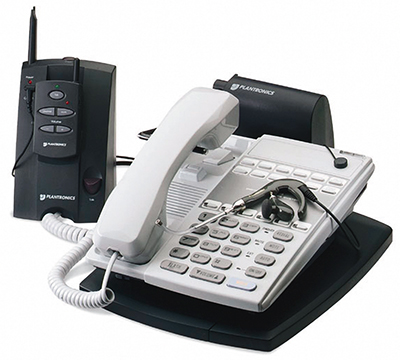
Plantronics, Inc.’s CA10CD cordless push-to-talk headset and amplifier gives call center agents and other business professionals room to roam.
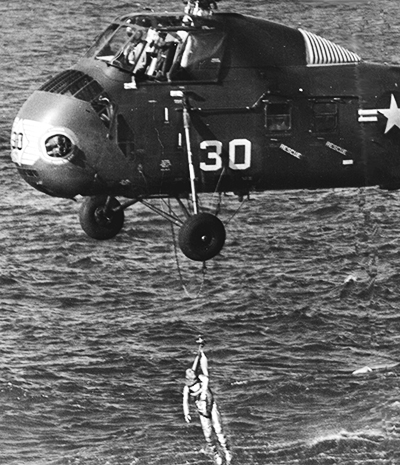
A U.S. Marine helicopter lifts astronaut Virgil Ivan “Gus” Grissom to safety, following splashdown of the Liberty Bell 7. The spacecraft had just sunk below the water.
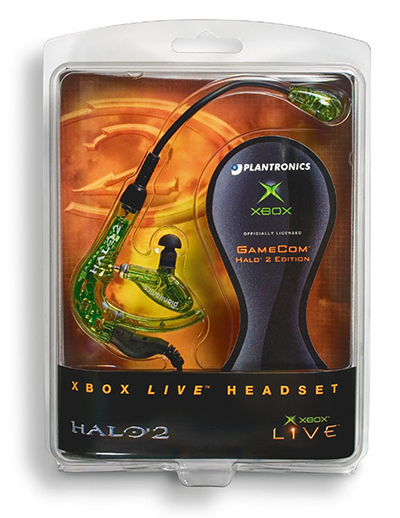
The GameCom Halo 2 Edition Xbox headset combines an innovative design with advanced microphone technology, resulting in a stable, great-sounding headset. The in-the-ear wearing style provides optimal fit and boom placement, which lets users hear and be heard clearly, even in the loudest game environments.
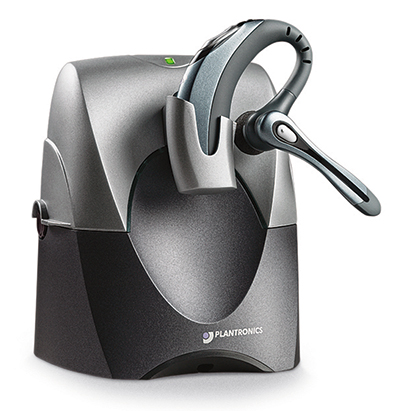
The lightweight and versatile Plantronics Voyager Bluetooth headset lets business professionals go wherever their conversations take them. It delivers all-day wearing comfort, clear voice transmission, and superior sound quality, all in an easy-folding design that slips into a pocket or purse for quick storage. With up to 6 hours of talk time, users can roam up to 33 feet from their Bluetooth devices.














